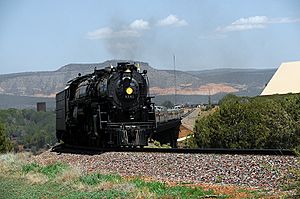Drake, Arizona facts for kids
Quick facts for kids
Drake, Arizona
|
|
|---|---|

Santa Fe 3751 pulls an excursion train across Hell Canyon on the BNSF, 2012
|
|
| Country | United States |
| State | Arizona |
| County | Yavapai |
| Elevation | 4,610 ft (1,410 m) |
| Time zone | UTC-7 (Mountain (MST)) |
| ZIP codes |
86334
|
Drake was a small, unincorporated community in Yavapai County, Arizona, United States. It was located near the Verde River. Drake was an important stop on the BNSF Railway's Phoenix Subdivision. It was also where the Verde Canyon Railroad began. A famous landmark in Drake is the old Hell Canyon Bridge, built in 1923. This bridge was once part of US Route 89 and is now a historic site.
Contents
History of Drake
Drake started as a town in the early 1900s. It grew from a work camp for building a very tall railroad bridge called the "Big Hell Canyon Railroad Bridge." This bridge was finished in 1901.
Early Days and the Railroad
The community was first known as Cedar Glade. In 1909, about 70 people lived there. In 1912, Cedar Glade became a key junction for the Verde Valley Railroad. This railway helped transport copper to a smelter in Clarkdale.
The railroad built around 20 structures in Cedar Glade. These included a train station, a house for the agent, a water tank, and several bunkhouses. The railroad kept a small team in Drake until the 1950s. Cedar Glade also had a place for travelers to stay and a store.
In 1920, the town's name changed from Cedar Glade to "Drake." The population of Drake was recorded as 18 people that year.
Life in Drake
In 1919, the towns of Puntenney and Cedar Glade faced a health challenge. They were placed under a special health restriction due to a widespread illness. People were not allowed to leave these communities. However, train passengers could still change trains at Cedar Glade.
In 1922, during a time when alcohol was illegal, there was a dramatic chase involving gunfire through the streets of Drake.
Education in Drake
Children in Drake were taught by teachers around 1920. Before that, they would cross the railway bridge to attend school in Puntenney, Arizona. In October 1919, a two-room house and the public school in Cedar Glade burned down, so school had to close.
A separate schoolhouse was built in Drake in 1928. Records show Barnetta Ball was a public school teacher in 1920. Elizabeth Stroud was also a teacher in Drake in 1922.
Drake's Changing Population
| Drake historical population |
||
|---|---|---|
| Year | Pop. | ±% |
| 1909 | 70 | — |
| 1920 | 18 | −74.3% |
| 1940 | 17 | −5.6% |
| 1960 | 12 | −29.4% |
Drake's population changed over the years. In 1909, there were 70 people. By 1920, it dropped to 18. In 1940, 17 people lived there, and by 1960, the population was 12.
Drake was also the closest community to the Little Hell Canyon Bridge. This was another road bridge about 8 miles (13 km) up Hell Canyon. It was also listed as a historic place in 1987.
The average yearly rainfall in Drake, which is in a valley at 4,610 feet (1,405 meters) high, was about 14.10 inches (0.358 m) in 1944.
In 1956, a company planned to build a cement factory in Drake. They had mining rights in the area.
Today, the road between Drake and Puntenney is blocked by the Drake Cement plant.
Drake is also home to the historic Cedar Glade Cemetery, also known as Drake Cemetery. This cemetery is on land owned by the Drake Cement Company. In 2019, the company announced plans to move the cemetery. It had burials from around 1891 to 1930.





